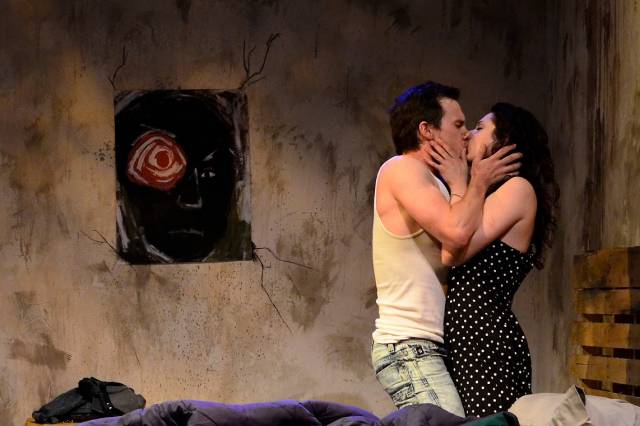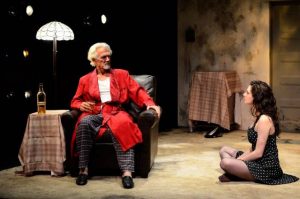

One of theater’s greatest gifts is that it can externalize the internal, connecting people by articulating emotions that are impossible to convey in ordinary life with ordinary language. John Patrick Shanley’s comedy of anguish, the dreamer examines his pillow, is legendary in the theater world for its striking and surreal study of relationships between men and women. Nearly 30 years after its premiere, The Attic Theater Company is staging a revival at the Flea Theater, and we spoke with the Attic’s Executive Director Ted Caine and Artistic Director, as well as director of the play, Laura Braza, about the dreamer’s significance, and why it’s so relevant to modern American society.

What aspects of the dreamer examines his pillow do you feel are the most quintessentially American?
Laura Braza: One of the things I think is deeply American about this play is Shanley’s dialogue, which I hear when I walk down the streets of Manhattan every day. I also think we’re in a cultural trend that is very American right now. It’s the self help trend. To me, this is a play about putting your faith in other people to help your life, rather than the self help way of improving yourself before you’re ready for others. I think it’s an interesting commentary on what is happening in our society right now.
Ted Caine: I find this play more universally relatable. I do agree that the dialogue and the cadence the characters speak in definitely has an American rhythm, but what excites me about this show is that it is all about a relationship and family.
Why did you feel that it was the perfect time to revive this particular play?
Laura: A couple of reasons. One, no one has seen it in New York in quite some time, and it’s been nearly 30 years since the original premiere. But more importantly with this sort of self help vibe, and our tendency to rely more and more on technology, we are getting away from this very simple idea that the solution to most of our problems are found in other people who we love, and who love us. We are in a moment that being reminded of this is very important.
How did you discover the dreamer, and what about it inspired you as a director?
Laura: I probably read it for the first time when I was 16. For a lot of reasons, everyone who has gone through a drama training program knows this play because it’s [mostly] two person scenes, which is what you are generally bringing into acting class. They’re fairly young characters. It’s good writing. Almost everyone I know, at least in the theater world, has seen scenes from this play, but not the whole play. And the same is true of me. I was just dying to actually see the play put together. I’ve always loved Shanley, and the dialogue is just so electric. It’s a play I’ve been dying to do for a long time, and we were finally able to make it happen.
How did you team up with the Flea Theater? Had you worked together previously?
Ted: Yes, this is our third year working with the Flea. We have a very good relationship with them. The Flea does work that is similar [and their] goals in the theater are similar to ours. I feel like we suit each other well. We first hooked up with the Flea because our resident scenic designer [Julia Noulin-Merat], who designed the dreamer, designed various shows for the Flea. She said, “these are great people.” I like to think of it as being love at first sight. We really enjoy working together, and it’s just a really mutually beneficial relationship.

What was the creative process like putting the play together with the actors, Lauren Nicole Cipoletti, Shane Patrick Kearns and Dennis Parlato?
Laura: This one was really fun because we really had time to delve into the text. We started at the table. We talked about the play. Then we just started doing it. We talked about what happens, what they learned, and what they needed. We talked a lot about the characters and put it into the dialogue. This one was for me very old school in terms of the rehearsal technique. There was no trick to it. We just kept going until we started to crack it open.
Ted: The actors are such pros. They’re just so talented and know how to do theater, smart actors. It makes it easier and very enjoyable to work with them.
Laura: It was a really fun group.
Have you worked with them before?
Laura: None of them, no. They come to us from Judy Bowman, a casting director who is--
Ted: Amazing.
Laura: -- quite good at her job.
How do you feel this play challenges the audience’s ideas about love and sex?
Laura: I can offer many answers to this question. The ending is abrupt and jarring and a little difficult. My hope is that it sends people out to talk more about what they saw. There is really no easy resolution to it, so they’re forced to talk to people they saw it with and try to figure out what everyone’s initial experience is. Everyone reacts to a different part of this play very personally and emotionally depending on where they are at in their life and in love. You have that element of this beautiful thing that I think we do as humans, which is when we need poetry, when we need tightened language to express what we’re feeling, we find it within us. Shanley’s got such a great tap on that. I think, if nothing else, experiencing and being in this play with these actors, who handle it so adeptly, opens the door for other people to begin to name and articulate the feelings in their lives.
Ted: Totally. I also think that in America, in particular, talking about sex can be very taboo, especially parents and their children talking about sex. So, that’s one thing I love about this play. It puts it all out there. It gets to the underlying feeling of love, lust, sex without being graphic or anything too over the top. I think it’s important for people to be able to talk about sex and love, and feel like they can share with other people.

Laura: The characters in this place are brave enough to talk about these things, even though it’s uncomfortable to talk about. Even though it’s risky to talk about your vulnerability and sex and love. They are so brave for such a long and high octane period of time in that 90 minutes that I think it just lends itself to the audience leaving with the same energy.
What would you like audiences to come away with after watching a performance?
Laura: I want them to go and have a drink and talk about their lives, honestly. That is my ultimate goal. And that idea of bravery is really an important point to me. It’s very close to my heart. I will get this quote wrong, but Shanley says in his introduction to the play something along the lines of, most moments in life require a little bit more bravery than we have at that moment. Just a deep breathe and a leap. I hope this play encourages people to approach life with that same sort of velocity and bravery.
The Attic Theater Company performs "the dreamer examines his pillow" at The Flea through August 15.